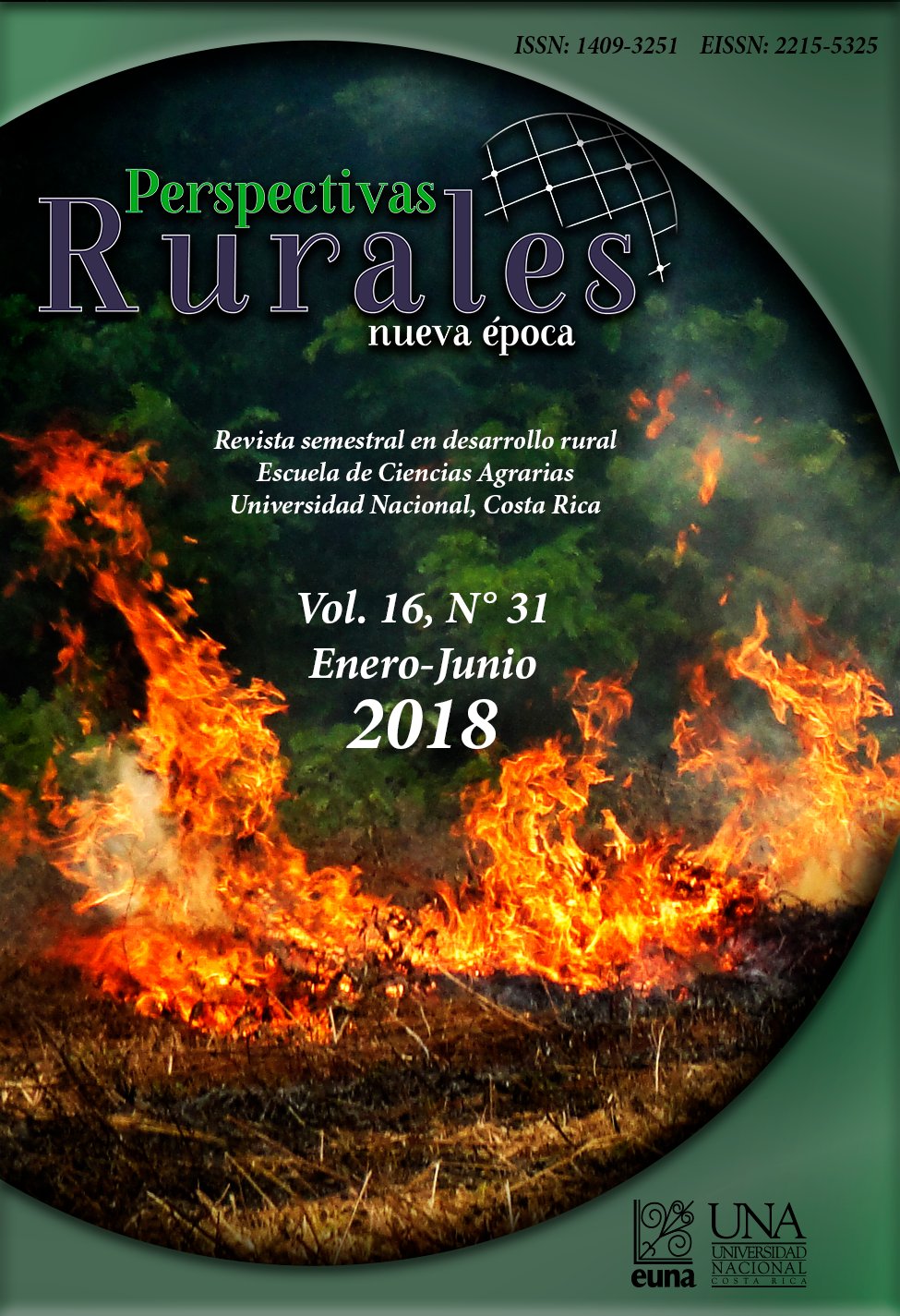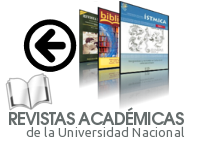Postfire Palm Resprouting in the Amazonian Forest: are Underground Stems an Advantage?
DOI:
https://doi.org/10.15359/prne.16-31.1Keywords:
surface-fire, fire ecology, regenerationAbstract
Despite the fire is the least studied impact among the current disorders affecting tropical American palms, the Arecaceae family is ideal for studies of resilience and impacts. The present study was the first to quantify and describe the postfire palm resprouting in the Amazon rainforest. We tested a set of juveniles and mature individuals of 10 palm species, to assess which morphological characteristics are related to postfire mortality or resprouting, so the aim of this study was to 1) record the possible response strategies of understory palms to fire disturbance; 2) compare the postfire responses between underground-stemmed and aerial stem species, and 3) compare the postfire responses between species with and without clonal ability. For all species of palm trees subjected to this experiment, the fire was not capable of eliminating all individuals, and after ~140 days after fire, we found that aerial stems had more basal sprouts than underground stems. Underground-stemmed species had more apical regrowth than for the aerial stems species. The number of resprouting individuals is greater in clonal species than in non-clonal species. Therefore, we conclude that palm species in the western Amazon have differential responses to fire impact.
References
Abrahamson, W. G. (1999). Episodic Reproduction in Two Fire-Prone Palms, Serenoa repens and Sabal etonia (Palmae). Ecology, 80(1):100–115. DOI: doi.org/10.2307/176982
Aponte, H., Kahn, F., & Millán, B. (2011). Vegetative adaptability of the Peruvian palm Astrocaryum perangustatum to deforestation. Revista Peruana de Biología, 18(2): 179-183. DOI: doi.org/10.15381/rpb.v18i2.225
Armenteras, D., González, T., & Retana, J. (2013). Forest fragmentation and edge influence on fire occurrence and intensity under different management types in Amazon forests. Biological Conservation, 159: 73-79. DOI: doi.org/10.1016/j.biocon.2012.10.026
Balch, J. K., Massad, T.J., Brando, P.M., Nepstad, D.C., & Curran, L. M. (2013). Effects of high-frequency understorey fires on woody plant regeneration in southeastern Amazonian forests. Philosophical Transactions of the Royal Society B: Biological Sciences, 368(1619): 20120157–20120157. DOI: 10.1098/rstb.2012.0157
Barot, S., Mitja, D., Miranda, I., Meija, G.D., & Grimaldi, M. (2005). Reproductive plasticity in an Amazonian palm. Evolutionary Ecology Research, 7(7): 1051-1065. https://www.researchgate.net/publication/228676243_Reproductive_plasticity_in_an_Amazonian_palm
Bond, W. J. & Midgley, J. J. (2003). The Evolutionary Ecology of Sprouting in Woody Plants. International Journal of Plant Sciences, 164 (S3): S103–S114. DOI: doi.org/10.1086/374191
Certini, G. (2005). Effects of fire on properties of forest soils: a review. Oecologia, 143(1):1–10. DOI: 10.1007/s00442-004-1788-8
Clarke, P. J., Lawes, M.J., Midgley, J.J., Lamont, B.B., Ojeda, F., Burrows, G., ... Knox, K.J.E. (2013). Resprouting as a key functional trait: how buds, protection and resources drive persistence after fire. The New Phytologist, 197(1):19–35. DOI: 10.1111/nph.12001
Cochrane, M., Alencar, A., Schulze, M., Souza Jr, C., Nepstad, D., Lefebvre, P., & Davidson, E. (1999). Positive feedbacks in the fire dynamic of closed canopy tropical forests. Science, 284(5421):1832–1835. DOI: 10.1126/science.284.5421.1832
Coe, M. T., Marthews, T. R., Costa, M.H., Galbraith, D.R., Greenglass, N.L., Imbuzeiro, H.M.A., ... Wang, J. (2013). Deforestation and climate feedbacks threaten the ecological integrity of south-southeastern Amazonia. Philosophical transactions of the Royal Society of London. Series B, Biological sciences, 368(1619):20120155. DOI: 10.1098/rstb.2012.0155
Flinn, M. A., and Wein, R. W. (1977). Depth of underground plant organs and theoretical survival during fire. Canadian Journal of Botany, 55(19): 2550-2554. DOI: doi.org/10.1139/b77-291
Gehring, C., Zelarayánet, M.L.C., Almeida, R.B., Moraes, F.H.R. (2011). Allometry of the babassu palm growing on a slash-and-burn agroecosystem of the eastern periphery of Amazonia. Acta Amazonica, 41(1), 127-134. DOI: dx.doi.org/10.1590/S0044-59672011000100015
Hirota, M., Holmgren, M., Van Nes, E.H. & Scheffer, M. (2011). Global Resilience of Tropical Forest and Savanna to Critical Transitions. Science, 334(10):232–234. DOI: 10.1126/science.1210657
Keeley, J. E., Pausas, J.G., Rundel, P.W., Bond, W.J., & Bradstock, R.A. (2000). Fire as an evolutionary pressure shaping plant traits. Trends in plant science, p 1–6. DOI: 10.1016/j.tplants.2011.04.002
Krieger F, G. C., Bufacchi, P., Santos, J.C., Gurgel V, C.A., Alvarado, E.C., Mell. W., & Carvalho Jr, J.A. (2017). Probability of surface fire spread in Brazilian rainforest fuels from outdoor experimental measurements. European Journal of Forest Research, 1-16. DOI: doi.org/10.1007/s10342-016-1023-2
Laurance, W. F., Camargo, J.C., Luizão, R.C., Laurence, S.G., Pimm, S.L., Bruna, E. M., ... Lovejoy, T.E. (2011). The fate of Amazonian forest fragments : A 32-year investigation. Biological Conservation, 144(1):56–67. DOI: 10.1016/j.biocon.2010.09.021
Liesenfeld, M.V.A., Vieira, G., & Miranda, I. P. A. (2016). Ecologia do fogo e o impacto na vegetação da Amazônia. Pesquisa Florestal Brasileira, 36(88):505-517. DOI: doi.org/10.4336/2016.pfb.36.88.1222
Michaletz, S. & Johnson, E. (2007). How forest fires kill trees: A review of the fundamental biophysical processes. Scandinavian Journal of Forest Research, 22(6): 500–515. DOI: 10.1080/02827580701803544
Miola, D. T., Correia, H.V., Fernández, G. W., & Negriros, D. (2010). The effect of fire on phenology of Syagrus glaucescens Glaz. ex Becc. (Arecaceae). Neotropical Biology and Conservation, 5(3): 146-153. DOI: 10.4013/nbc.2010.53.02
Morton, D. C., Le Page, Y., DeFries, R. Collatz, G.J., & Hurtt, G.C. (2013). Understorey fire frequency and the fate of burned forests in southern Amazonia. Philosophical transactions of the Royal Society of London. Series B, Biological sciences, 368(16199): 20120163. DOI: 10.1098/rstb.2012.0163
Pausas, J.G. & Keeley, J.E. (2014). Evolutionary ecology of resprouting and seeding in fire-prone ecosystems. New Phytologist, 204(1): 55-65. DOI: doi.org/10.1111/nph.12921
Rocha, G. P., Vieira, D.L.M., & Simon, M.F. (2016). Fast natural regeneration in abandoned pastures in southern Amazonia. Forest Ecology and Management, 370: 93-101. DOI: doi.org/10.1016/j.foreco.2016.03.057
Rogers, B.M., Soja, A.J., Goulden, M.L., & Randerson, J.T. (2015). Influence of tree species on continental differences in boreal fires and climate feedbacks. Nature Geoscience, 8: 228–234. DOI: doi.org/10.1038/ngeo2352
Salm, R. (2005). The importance of forest disturbance for the recruitment of the large arborescent palm Attalea maripa in a seasonally-dry Amazonian forest. Biota Neotropica, 5(1): 35-41. DOI: doi.org/10.1590/s1676-06032005000100004
Silvestrini, R. A., Soares-Filho, B.S., Nepstad, D., Coe, M., Rodrigues, H., & Assunção, R. (2011). Simulating fire regimes in the Amazon in response to climate change and deforestation. Ecological Applications, 21(5): 1573–1590. DOI: 10.1890/10-0827.1
Simões, C. G. & Marques, M. (2007). The role of sprouts in the restoration of Atlantic Rainforest in southern Brazil. Restoration Ecology, 15(1): 53-59. DOI: doi.org/10.1111/j.1526-100x.2006.00189.x
Tomlinson, P. B. (1979). Systematics and ecology of the Palmae. Annual review of ecology and systematics, 10(1): 85-107. DOI: doi.org/10.1146/annurev.es.10.110179.000505
Uhl, C. & Kauffman, J. B. (1990). Deforestation, Fire Susceptibility, and Potential Tree Responses to Fire in the Eastern Amazon. Ecology, 71(2): 437–449. DOI: 10.2307/1940299
Verdú, M., Pausas, J.G., Segarra-Moragues, J.G., & Ojeda, F. (2007). Burning phylogenies: fire, molecular evolutionary rates, and diversification. Evolution; international journal of organic evolution, 61(9): 2195–2204. DOI: 10.1111/j.1558-5646.2007.00187.x
Vesk, P.A. & Westoby, M.S. (2004). Sprouting ability across diverse disturbances and vegetation types worldwide. Journal of Ecology, 82(2): 911–320. DOI: 10.1111/j.0022-0477.2004.00871.x
WGII, IPCC. (2014). Climate change 2014: impacts, adaptation and vulnerability. Working Group II, IPCC 5th Assessment Report, http://www.ipcc.ch
Wuschke, M. (1999). Fire Resistance in a Queensland Livistona. Palms (Principes), 43(3): 140–144.
Downloads
Published
How to Cite
Issue
Section
License
![]()
Revista Perspectivas Rurales. Nueva Época se encuentra bajo una licencia Creative Commons Reconocimiento-NoComercial-CompartirIgual 4.0 Internacional License.
Creado a partir de la obra en http://www.revistas.una.ac.cr/index.php/perspectivasrurales
Los autores/as que publiquen en esta revista aceptan las siguientes condiciones:
- Los autores/as conservan los derechos de autor y ceden a la revista el derecho de la primera publicación, con el trabajo registrado con la Licencia Creative Commons Atribución-NoComercial-CompartirIgual 4.0 Internacional, que permite a terceros utilizar lo publicado siempre que mencionen la autoría del trabajo y a la primera publicación en esta revista.
- Los autores/as pueden realizar otros acuerdos contractuales independientes y adicionales para la distribución no exclusiva de la versión del artículo publicado en esta revista (p. ej., incluirlo en un repositorio institucional o publicarlo en un libro) siempre que indiquen claramente que el trabajo se publicó por primera vez en esta revista.
- Se permite y recomienda a los autores/as a publicar su trabajo en Internet (por ejemplo en páginas institucionales o personales) antes y durante el proceso de revisión y publicación, ya que puede conducir a intercambios productivos y a una mayor y más rápida difusión del trabajo publicado.






 :
: 
